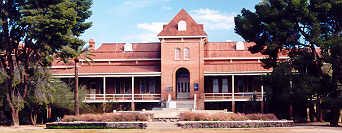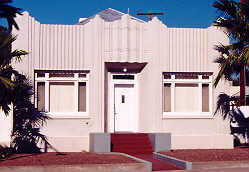University Walk
On the Friday after Thanksgiving, the Local Couple, feeling sluggish,
decided to take a walk. This time it was to include the
University of Arizona
and the 4th Avenue shopping district, with a smattering of interesting
neighborhoods tossed in for good measure. You see, when we were
finalizing our
Local Couple's
Downtown walk, we stopped in at the main library and picked out a
book on Tucson architecture
1 in the hopes of learning a
little
bit more about what there is to see in Tucson. By combining the
sections
on the University of Arizona and West University, we formulated a
Local
Couple's University map (also in
portrait mode for ease
of printing) for our walk that we thought would cover the more
interesting sights mentioned in the book.
That said, let's get walking. First, if you're not already in the UofA
area, there is a parking garage on the corner of Euclid and 2nd Street
that marks the start of our walk. As a side benefit, this garage is
free
on the weekends; on weekdays you'll probably find it difficult to park
around campus (these
parking maps made by the UofA may help). That's the
downside to having a vibrant University right downtown; the only
downside, we might add. A quick note about the area: many of the
streets
are numbered, with avenues running north-south, and streets running
east-west. Thus, you can be at the corner of 2nd Street and 2nd Avenue.
So check the outline on the map to make sure you're headed in the
right direction.

Leaving the parking garage, we head west on 2nd Street. Just past the
Marriott, on the north side is
Site 1:
The
Arizona
Historical Society Museum. The stone portal on the front graced the
original San Agustín Cathedral (demolished 1936). Now don't just
stand there admiring the outside, step inside and check out the museum
itself (there's a request for a five dollar per head donation; give it,
you won't be sorry). It is wonderfully done, with exhibits ranging from
photos of early Tucson and Arizona, a large exhibit on mining
(including
a mine shaft), an excellent treatment dealing with the changes in
women's clothing and fashion, decade by decade, starting around 1900.
We
happen to think that this museum is one of the lesser known gems in
Tucson.
Leaving the museum, (if you still have time and energy to finish the
walk) head south on Park Avenue, until you reach University Boulevard
and the main gate for the UofA. Made of volcanic rock in 1916, the gate
forms the boundary between the bustle of the city and the calm of the
open, green campus, thus earning it the
Site
2 designation on the Local Couple's University Walk.
Head directly into the campus, and soon you'll be flanked on the north
and south by the
Arizona State Museum (
Site
3). The North building was the original library for UofA, and
the South building was the original anthropology building. Sometime
make
a point of stopping into this museum, also. Charging no admission (but
taking donations), the Arizona State Museum houses some of the best
examples of Tohono basketry and prehistoric pottery around. In the
past,
the Museum also had a small display of old Oaxacan carved animals;
these
particular carvings, while unrefined compared to today's more
commercial
offerings, were special. You could tell immediately that they were not
made for selling; these were made with all the care the carvers could
muster. These are real Oaxacan carvings.
Continuing east on University Avenue, past the barricades that make
this a pedestrian only zone, you'll come upon the defining building for
the University, and perhaps Tucson, itself: Old Main. This wonderful
structure is the University's first permanent building (1891), and, we
think, its best. With its wrap-around veranda and partially sunken
first
floor, buildings just don't get any better than this one. Naturally,
this is
Site 4. It's amazing,
no, unbelievable is the right word, to realize when you look at Old
Main, that in the 1960's the University wanted to raze it! Yes, raze
it.
We don't know what they wanted to put in its place (probably a parking
lot), but we're sure it wouldn't have been an improvement. Fortunately,
a campaign to save Old Main was started and wiser heads prevailed. As
we
will see on our walk, this isn't the only idiotic idea that the
University has had over the years that has had to be stopped with a
public campaign. See, for example, our next stop.
Passing Old Main to the south, continue east through the park-like
green lawns until you get to
Site 5,
the Joseph Krutch garden. This small desert garden in the median of
what used to be Cherry Avenue houses three of the best examples of
boojums here in Tucson, perhaps the United States. These are some of
the
finest ones we've seen anywhere, and that includes the
Arizona-Sonora
Desert Museum,
Tohono Chul, and the Arboretum at the
San Diego Wild Animal
Park. Their only rivals that we know of are at
Boyce Thompson
Arboretum. So, of course, just this year (2002), the University
wanted to remove them! And guess what was going to go in their place?
Yep, more lawn! Here you have some of the best examples of a tree that
most people haven't even
heard
of, much less seen, and you want to move them off someplace so you can
put in more lawn. Words just fail me. Again, the public and students
had
to rally, and the boojums were saved.
Let's move on before one-half of the Local Couple becomes incoherent at
the thought of such stupidity and head on past the Integrated Learning
Center with its partly underground patios, past the
Flandrau Science Center,
Planetarium, and Mineral Museum (
Site 6),
and out to Campbell Avenue; be sure to notice the clothespin-like
sculpture. We call this
Site 7,
just because it's a good place to turn around and head back down the
mall. Plus, we kind of like the sculpture.
Retrace your steps all the way back to the Main Gate, but make sure to
go around the north side of Old Main, where you get a chance to see a
nice example of a cresting saguaro. This crest occurs when the growth
point, or meristem, elongates to a line, causing the folded, fan-like
growth. No one knows what causes this cresting, but apparently it
occurs
in all plants. Also to the north of Old Main, you can find one of the
largest Kapok (Silk Floss) trees we have seen. Kapok trees, with their
thorn covered trunks, look like something out of a Dr. Seuss book, and
besides, it's fun to say Kapok. A side note: the University grounds are
a designated arboretum, so you'll find a number of interesting trees if
you just go looking. Many are labeled, too, so you'll know what
it
is you're seeing.
Head straight down University Blvd., past the Chipotle Mexican Grill
(don't eat there, it's just a McDonalds; you can find a
good
restaurant elsewhere). As you walk down University, you'll move into
more of a residential area, with a nice streetscape. In particular,
check out the Art Deco façade on the house at 521 E. University.
Isn't that great! Just looking at it, you know this is
Site 8 on the Local Couple's
University Walk. Much of the rest of University Blvd. has wonderful
examples of 1930's bungalows that are in various states of renovation
or
restoration; enough, in fact, to make it a fun stroll
.
As you approach Stone Avenue, the grittiness of the city returns for
the next couple of blocks. If you're not interested in Art Deco
architecture, you can easily cut one block down 6th Avenue and resume
the walk at 6th and 4th Street. We won't be offended. Otherwise,
turn south on Stone, walk down one block, and you will find the Art
Deco
gas station (
Site 9). It's not
used as a gas station any more, which is a shame, but it looks cool,
with its ice cream cone swirl roof and adjacent canopy. After admiring
the swirled roof, and thinking how cool it would look with glowing neon
striping along the canopy, a couple of snappy uniformed attendants
asking to fill 'er up, free air, and a quick cleaning of the
windshield,
snap out of it and realize that those days are gone forever. And that's
a real pity.

Turn east on 4th Street, and walk until you get to 4th Avenue (all of
which is
Site 10), where
you'll
find that not all of the past is gone. Heading south along 4th Avenue,
you'll find a small enclave of the 60's and 70's still holding forth.
Resale shops abound, along with art galleries, restaurants, bars, a
food
co-op, and several import shops. Head down one side of 4th Avenue, and
up the other, and make sure to go all the way to Coronado Hotel just
before the 4th Avenue underpass. Currently serving as apartments for
elderly and handicapped, this building is a reminder of when downtown
Tucson was the place to be. Return up 4th Avenue on the other side of
the street, and you'll pass Caruso's (an Italian restaurant and a
Tucson
landmark),
Native
Seed/SEARCH, and a jumble of other establishments. All of which
make good use of the existing architecture, making for an excellent
business streetscape.
When you reach University Blvd., turn east for a couple blocks, then
north on 1st Avenue. One block up is 2nd Street (as a side trip,
continue up 1st Avenue to the
Postal
History Foundation), where you'll turn east to return to the
starting point, the parking garage at Euclid Avenue and 2nd Street.
1
Anne M. Nequette and R. Brooks
Jeffery,
A Guide to Tucson
Architecture, The University of Arizona Press/Tucson, 2002.








